
|
|
|
|
BY: SUN STAFF
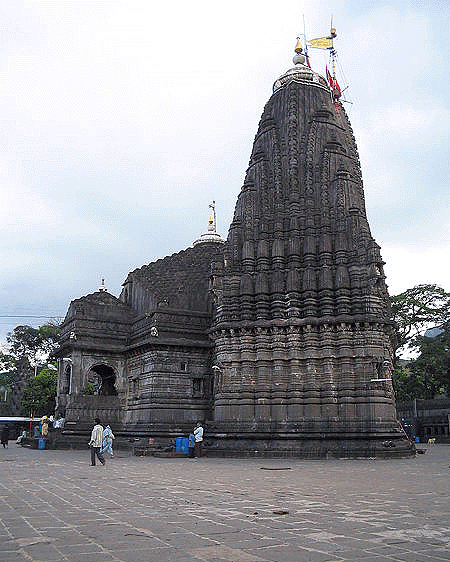
Triyambakeshwar Temple at Nasika Apr 01, CANADA (SUN) — A serial exploration of the holy sites visited by Lord Caitanya. Nasika
As Lord Caitanya's South India preaching tour drew to a close, He visited the ancient tirtha at Nasik, Maharashtra, as mentioned in the Summary of Sri Caitanya-caritamrta, Madhya Lila 9:
Madhya 9 Summary "The Lord then visited Tapi, Mahismati-pura, the Narmada River and Rsyamuka-parvata. He entered Dandakaranya and liberated seven palm trees. From there He visited a place known as Pampa-sarovara and visited Pancavati, Nasika, Brahmagiri and also the source of the Godavari River, Kusavarta." Later in Madhya Lila we find additional information about the Lord's pastimes at Nasika: Madhya 9.317
"Sri Caitanya Mahaprabhu then visited Nasika, where He saw the deity of Tryambaka [Lord Siva]. He then went to Brahma-giri and then to Kusavarta, the source of the river Godavari. PURPORT Nasik is situated approximately 170 kilometers northeast of Mumbai. Twenty miles from the center of Nasik is the village of Tryambaka, where Brahma-giri and the source of the Godavari River are found. In an earlier segment of this series we visited Kusavarta , a famous theertham near Tryambaka which is the symbolic source of the Godavari. Devotees come here in great numbers to bathe in the ancient tank.
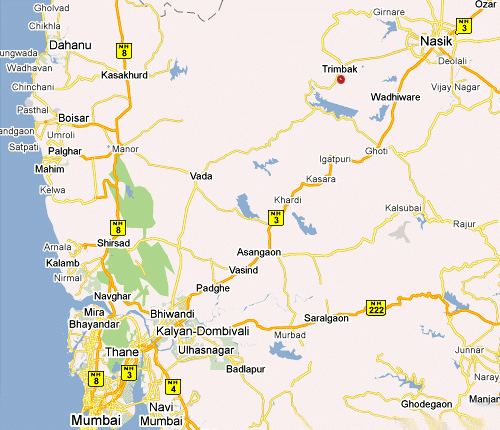
Trimbak and Nasika In his purport to Madhya 9.317, Srila Prabhupada informs us that there is some controversy as to the location of Kusavarta, which some believe is at Vindhya rather than Nasika. However, the Triyambakeshwar Temple at Nasika is very well known, and we do not find another temple by the same name associated with Vindhya. The Vindhya Mountain range begins near the Gujarat peninsular, about 300 kilometers north of Nasik, running parallel to the Narmada River and east, almost to the Ganges at Mirzapur, The temple of Triyambakeshwar at Nasik is one of the twelve Jyotirlingas. The presiding Deity, Sri Triyambakeswar is a lingam having three faces which embody Lord Brahma, Lord Vishnu and Lord Rudra. Because all the Jyotirlingas have Shiva as their main deity, Srila Prabhupada states in Madhya 9.317 that at Nasika, the Deity visited by Lord Caitanya was Tryambaka, the name of Lord Shiva. In the book, Chaitanya and His Companions by Rai Sahib Dinesh Chandra Sen, B.A., (Univ. of Calcutta, 1917), we read the following passage, which is drawn in part from the diary of Govinda dasa. A number of details are given by Chandra Sen that are not found in the Caitanya-caritamrta regarding the places Lord Caitanya visited just prior to Nasika, and afterwards. "From the depth of the Choranandi forest Chaitanya emerged accompanied by Govinda and Naroji and proceeded towards Khandala, a village on the river Mula. The people of Khandala were so hospitable that they quarrelled among themselves over their rival claims of entertaining their guest. "I saw him first" one of them would say, when another gave him the lie and often the quarrel that ensued resulted in a hand to hand fight. Chaitanya stood quiet and would not go to anyone's house, though so many were eager to have him. A rich man offered him fine clothes and a good meal. Chaitanya said "These two men with me have got alms given by some poor people. So I do not need your presents. The whole world with all its glories will pass away like a dream and you and I shall be nowhere, my friend. Only the Lord will be there. I seek Him and not rich food or clothes." So saying he closed his eyes from which fell tears of spiritual ecstasy, while Naroji sat by him in mute wonder. Chaitanya next visited Nasik and Trimukha and then came to Panchavati. Here he had vision of God and he closed his eyes, while his face flowed with radiance. Govinda said tht as he saw him in that condition he was struck by the sight, and thought that he saw a flood. Chaitanya proceeded thence to Damana and still further north where wandering for fifteen days he came to the ancient city of Suratha. The Goddess Astabhuja was there, it is said, established by Raja Suratha himself. Here an ascetic asked him how God should be loved. Chaitanya said "Just as an ordinary woman when she falls in love with a handsome youth yearns for him so may the soul yearn for God. Chaitanya then advised the rich man to distribute his presents among the poor people who needed help."
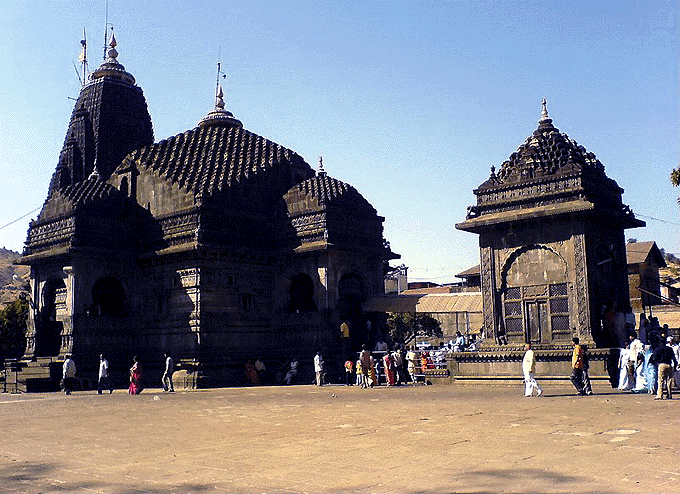
Triyambakeshwar Temple In the book Cultural History of Karanataka by Shri Krishnarao Hanmantrao Kabbur (Bombay, 1947), we find mention of Nasik as one of three locations that defined the boundaries of ancient Karnataka. In the Lilacaritra of Mahanubhavas (1190 A.D.), written in Marathi, these boundaries are described as three Khanda-mandalas or subdivisions of Maharastra: I. The First Mandala consisted of the country lying from Phalithana downwards to wherever the Marathi language was spoken; to the north of this was situated Baleghat. II. The Second Mandala consisted of the country lying on both the sides of the river Godavari to the extent of twelve Yojanas. To the west was situated Tryambakesvara (near Nasik). III. The Third Mandala comprised the country lying between Meghakara Ghat and Varhad (Berar). We find this reference interesting because the current northern border of Karnataka is about 470 kilometers south of Nasik. This is a good example of how much change has taken place with respect to ancient India's place names, and how such changes can impact our research into subjects like Sri Caitanya's tirtha-yatra. Nasik is also mentioned in discussions about the ancient dynasties of Karnataka. From pre-Ashokan times to the 3rd century A.D., the Satakarna dynasty was in power in Karnataka. The Satakarnis were a very ancient race belonging to the Satvata tribe. Known by many different names, the Satakarnis were comprised of different branches at Nanaghat, Nasik, Chanda and Koihapur. The branch at Nasik was ruled by Krsna (or Kanha), the brother of Simuka, who ruled the region from the west of Kalinga to Nasik, where he was headquartered. Triyambakeshwar Temple at Nasika Triyambakeshwar Temple is located 28 kilometers from the city of Nasika. The imposing black stone structure sits in the foothills, framed against the sacred Brahma-giri Mountain, from which three separate sources of the Godavari River emerge, flowing in three directions. The stream flowing east is called Godavari, the one flowing south is Vaitarna, and the third is called the west-flowing Ganga, which meets the Godavari near Chakra Tirth. The River Ahilya also meets the Godavari in front of the Triyambakeshwar Temple.
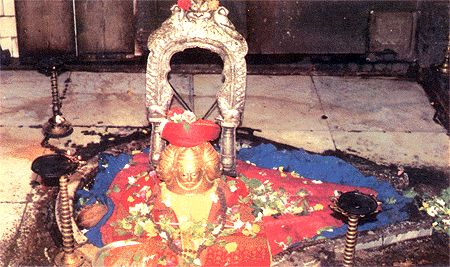
Triyambakeshwar-linga Having researched Triyambakeshwar Temple for last year's series on the Worship of Lord Brahma, we present some of that information here, describing the temple, deities and environs. The Trimbakeswar Jyotirlinga is extraordinary in several ways. It embodies all three of the Trimurti together: Visnu, Brahma and Siva. The lingam is comprised of three small, thumb-like linga, each a member of the Trimurti. They are swayambhua, or self-manifesting. The three lingam are covered with a mask, usually of silver, which bears the faces of the Trimurti. On special occasions a gold mask is worn, and upon this a jeweled crown is placed. The crown, covered in precious gems, is from the age of the Pandavas. Trimbakeshwar is the only Jyotirlinga where the lingam sits in a depression on the floor, rather than projecting upwards, above it. Consequently, the trilingam in the sanctum is not worshipped with abhisheka in the usual way. Here, there is just the bottom part of the pounding stone (ukhali), which is a depression in which the three lingams sit. The Linga of Mahesha has a constant stream of natural water flowing over it. It is said that flames sometimes issue forth from the lingam depression, as well as a rumbling sound. Sri Trimbakeswar is worshipped here with several offerings a day. During the evening puja, the Deity's mask is removed and placed on a bed, in the hall of mirrors. Every Monday the silver mask is taken to the Kusavarta tank and given holy bath. A similar ritual takes place with the golden mask at each Shivratri, and on the full moon day in the month of Kartik.
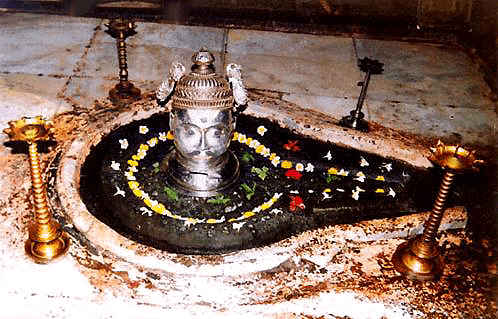
Sri Triyambakeshwar's silver crown Trimbakeshwar (Tryambakeshwar, Trambakeshwar) takes its name from 'Trimbaka', which means The Lord Who has Three Eyes. This is a place of Tri-Sandhya Gayatri, the birthplace of Lord Ganesha, and the site of the first Nath of the Nath Sampradaya. Sinhastha Mahatmya mentions that like Lord Caitanya, Lord Rama also made the yatra at Trimbakeshwar. Trimbakeshwar is considered to be one of the holiest places to perform Shraddha. The Nirnaya Sindhu mentions Trimbakeshwar as the place where Sahyadri Mountain and Godavari River exist, purifying the entire earth planet. The sage Gautama had his ashrama in Trimbakeshwar, and during a 24-year period of drought, his pious credits caused Varuna to make the rains fall here. Indra became envious of the boon being enjoyed by Gautama, and caused even more rain to fall. Later, Gautama engaged in the episode of accidentally killing a cow, and in penance he performed austerities on the peak of the Brahmagiri. His prayers to Shiva resulted in the Ganges manifesting here, at Trimbak Tirth. Taking bath in this Kusavarta, Gautama was able to rid himself of the sin of cow killing. Kusavarta kund is considered to be the symbolic origin of the Godavari. The work of constructing the present main temple of Trimbakeshwar, built with black basalt, was begun by Shrimant Balaji Bajirao, the Nanasahib Peshawe, in 1755 and was completed in 1786, at a cost of 16 lacs. The Shiva deity installed in the temple at that time was decorated with a world famous gem – the Nassak diamond. The stone was appropriated by the British during the 3rd Anglo-Maratha war, and is currently in the hands of a U.S. businessman. Trimbakeshwar Temple was built in the Nagara style. It is surrounded by a massive stone wall. A large Nandi sits in front of the temple, while a second beautiful marble Nandi is found inside. The garbhagriha is square internally, but is star-shaped externally. The porches have pillars and arches. The structure is replete with intricate sculptural work of scrolls, floral ornaments, and figures of various transcendental personalities and scenes. The Triambaka-lingam is housed in the sanctum, crowned with a graceful tower, a large amalaka and a golden kalasha. In front of the garbagriha and the antarala there is a mandap with doors on four sides, three of which are covered with porches. The roof of the mandapam is a curvilinear slab, rising in steps. Outside the temple is another area with linga and yoni installed, and separate pujas are done here. To the rear of the temple's Gangamandir is a large caravansary, where Rama and Karpureshwar Mahadev are enthroned. There is also a separate temple of Ashwini Kumar in front of Gangamandir, temples of Jwareshwar Mahadev and Kanchaneshwar, and murtis of the Dasavatar and thirty-three other divine personalities. It is said that by Lord Shiva's order, all the deities stay here in person during the period of Sinhastha Parva, coming to purify themselves.
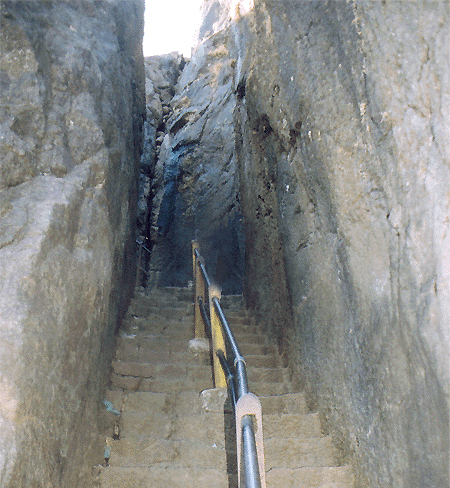
Pradakshina route through Brahma-giri Hill There are two pradakshina routes around Trimbakeswar Kshetra. One circumambulates Brahma-giri, while the other goes around Hariharagiri. There are a great many temples, shrines and theertham all in close proximity to the Trimbakeshwar Temple complex. Seven km. away is Anjaneri mountain, the birthplace of Hanuman. The town has a large population of Brahmin households, so there are many gurukuls and learning centers. The place is also famous for the opulent religious rituals (vidhis) performed by brahmans, who have specialized in them. Narayan-Nagbali, Kalsarpa Shanti, Tripindi vidhi are done here. Narayan-Nagbalipuja is performed at Trimbakeshwar only, on certain days. While popularly known as the Nashik Mela, Trimbakeshwar is actually the location of the Kumbha Mela. Held once every 12 years during Simhasta Parvani, when Jupiter enters Leo, all the sacred waters gather together here in the Kusavarta kunda. Over 3.5 million devotees throng to Trimbakeshwar for this great Mela. Mahashivaratri and Rathayatra are also held here.
| |